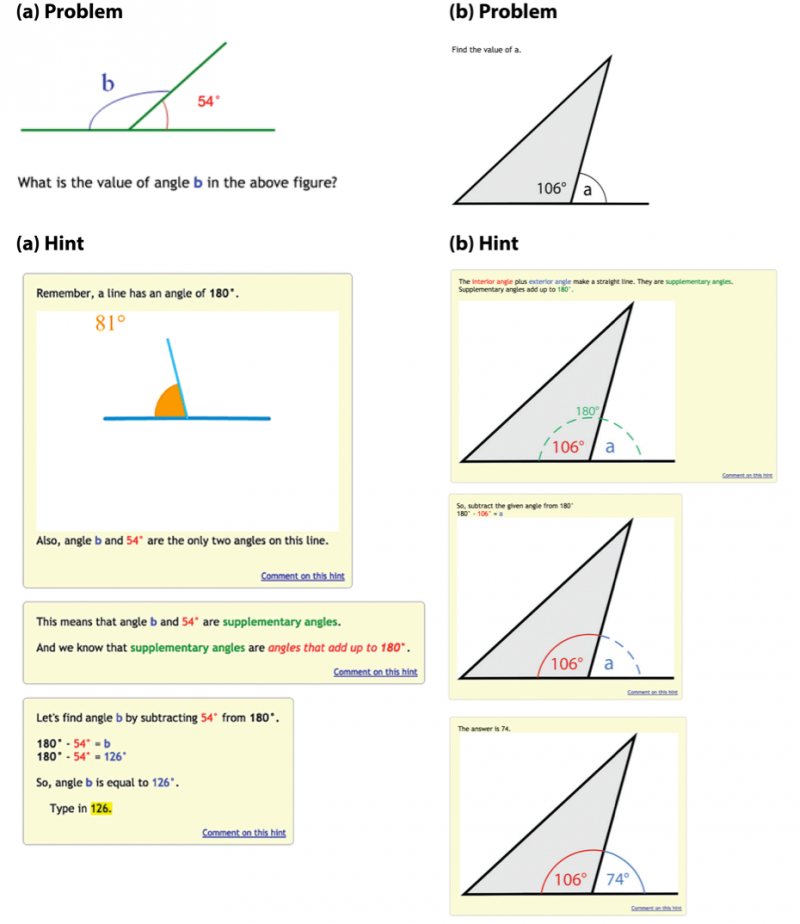Consistent Language
| Consistent Language | |
| Contributors | Paul Inventado Peter Scupelli |
|---|---|
| Last modification | November 6, 2015 |
| Source | {{{source}}} |
| Pattern formats | OPR Alexandrian |
| Usability | |
| Learning domain | General |
| Stakeholders | Teachers Students |
| Production | |
| Data analysis | Student affect and interaction behavior in ASSISTments |
| Confidence | |
| Evaluation | PLoP 2015 writing workshop Talk:ASSISTments |
| Application | ASSISTments |
| Applied evaluation | ASSISTments |
If students become frustrated when elements in the problem are written inconsistently, use the same language throughout the problem.
Context
Students are asked to answer a problem on an online learning system. The system allows students to request for hints to help them solve the problem. Teachers design problems, and their corresponding hints.
Problem
Students become frustrated when elements in the problem are written inconsistently.
Forces
- Working memory. Working memory can only hold a limited amount of information over a short period of time especially if it is new information. Cognitive load increases as more information is held in the memory while performing a task[1].
- Split-attention effect. Unnecessary processing of information imposes a cognitive load that interferes with learning. High cognitive load impairs performance, which could increase the difficulty of a learning task[1].
- Affect. When students experience too much difficulty or get stuck in trying to solve a problem, they are likely to disengage from the activity[2].
- Limited resources. Student attention and patience is a limited resource possibly affected by pending deadlines, upcoming tests, achievement in previous learning experiences, motivation, personal interest, quality of instruction, and others[3].
Solution
Therefore, use the same language throughout the problem.
The term language is used loosely to refer to different aspects of the problem such as term usage, text formatting, color usage, notations, visual representations, and others.
Consequences
Benefits
- Students will keep track of less information in working memory.
- Students do not need to spend unnecessary effort to discover the relationship between different representations used in the problem.
- Students understand problems easier and are more likely to be engaged.
- Students with better learning experiences are more inclined to continue learning.
Evidence
Literature
Peterson and Peterson[4] found that unfamiliar combinations of letters could only be held in memory for a few seconds. In a different study, Miller[5] indicated that working memory could only hold five to nine chunks of unfamiliar information at a time. Learners are more likely to perform better when working memory is not overloaded by unnecessary information[1].
Discussion
Shepherds and stakeholders (i.e., data mining experts, ITS experts, and educators) agreed that the problem recurs in online learning systems and the solution could properly address the problem.
Data
According to an analysis of ASSISTments’ data, frustration correlated with problems that used its elements inconsistently. For example, a math problem dealing with angles used the degree notation inconsistently – “Subtract the given angle from 180°. 180 - 47 = 133.” In another instance, different instructions for inputting the answer were given in the problem and in the hints.
Related patterns
Using elements consistently throughout the problem help build a Familiar language[6] for students. When they answer similar problems in the future, they can easily understand them. Less effort will be needed to discover relationships between different representations in the problem.
Example
When a teacher designs a problem involving angles, he/she uses the degree notation consistently to refer to angles. The same notation is also used in the hints and instructions associated with the problem.
References
- ↑ 1.0 1.1 1.2 Sweller, J. (2004). Instructional design consequences of an analogy between evolution by natural selection and human cognitive architecture. Instructional science, 32(1-2), 9-31.
- ↑ D’Mello, S., and Graesser, A. (2012). Dynamics of affective states during complex learning. Learning and Instruction, 22(2), 145-157.
- ↑ Arnold, A., Scheines, R., Beck, J.E., and Jerome, B. (2005). Time and attention: Students, sessions, and tasks. In Proceedings of the AAAI 2005 Workshop Educational Data Mining (pp. 62-66).
- ↑ Peterson, L. and Peterson, M. (1959). Short-term retention of individual verbal items. Journal of Experimental Psychology 58: 193–198.
- ↑ Miller, G.A. (1956). The magical number seven, plus or minus two: Some limits on our capacity for processing information. Psychological Review 63: 81–97.
- ↑ Van Duyne, D.K., Landay, J.A., and Hong, J.I. (2007). The Design of Sites. Prentice Hall, Upper Saddle River, NJ.

